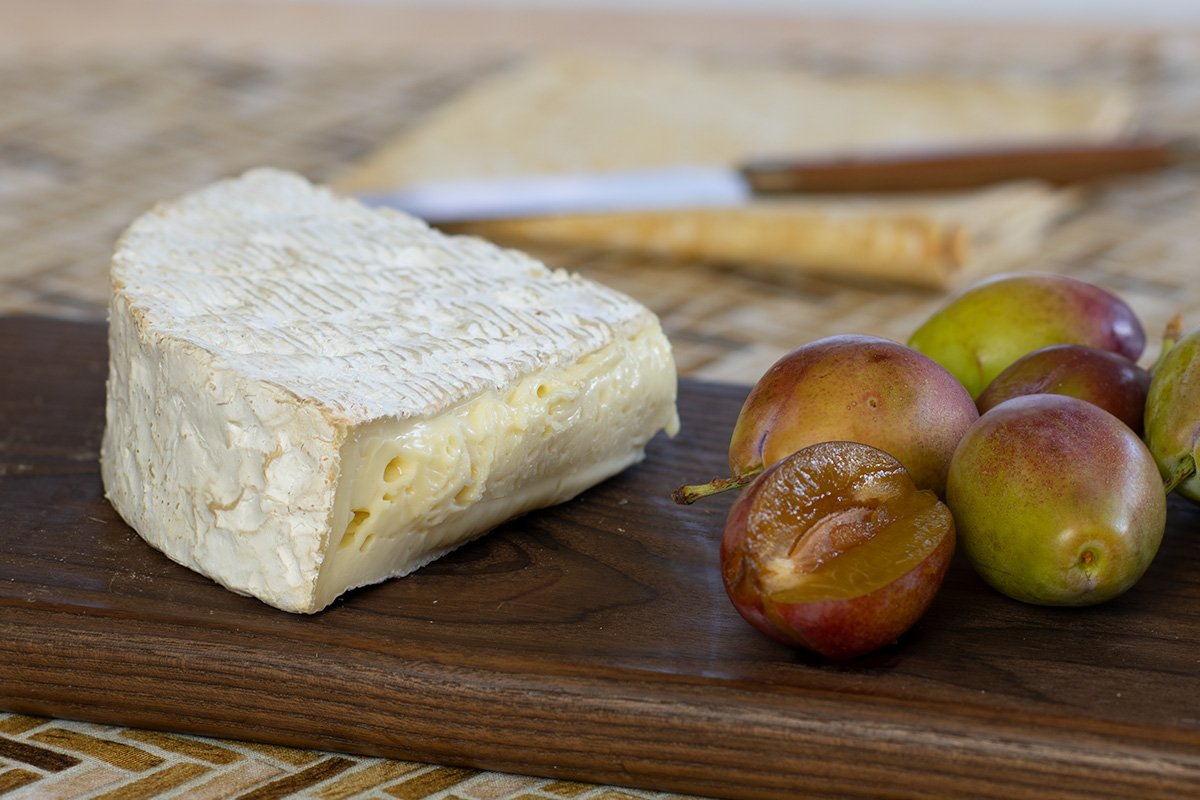The trend line for American raw-milk cheese is not what I wish it were. Over the past few years, we’ve seen a decline in the number of creameries producing cheese from unpasteurized milk, according to member surveys commissioned by the American Cheese Society. Cascadia Creamery’s Glacier Blue (above) remains among those cheeses made the traditional way, with milk at the temperature it comes from the animal. But the niche is shrinking.
Read moreGoat Cheese and Grilled Veggies Make a Tostada Masterpiece
Photo: Jeff Babcock
To answer your first question: Yes, it’s as good as it looks. And a breeze to make. Wish I had thought of it, but at least I recognize a genius idea when I see one. Crisp tostada, warm soft goat cheese, grilled autumn vegetables. My friend-in-cheese and talented cook Jeff Babcock was experimenting with fresh chèvre at home when this tasty concept took shape.
Read moreLose One, Gain One
Losing a great American cheese is a bummer—especially a cheese that so many loved—but a new arrival can soften the blow. So while I’m still in mourning for Ewereka, a blue-ribbon sheep Cheddar that Central Coast Creamery has discontinued, I’m enthused about its just-released replacement. Unforeseen hurdles compelled the Paso Robles, California, creamery to ditch Ewereka, but just wait until you taste the newcomer (above). Cheesemaker Reggie Jones has the American palate and purse dialed in, and I’d bet a bundle that this value-priced newbie will fly out of cheese shops.
Read moreWe Have a Winner!
Sam Rollins of Portland, Oregon, placed second at the Mondial du Fromage earlier this month, just four points behind the victor, Vincent Philippe of France’s Maison Bordier. Rollins’s finish was by far the best showing for an American to date in this international cheesemonger competition. One of two Americans representing the U.S. (American Nick Bayne competed for the UK and finished third), Rollins spent months beefing up his cheese knowledge and designing his platters for the grueling day-long contest. Via email, he told me how he prepared for the event and shared the highs and the lows (there weren’t many) of his Mondial experience.
Read moreNot Done with Burrata
Photo: Mari Havens
The tomatoes are winding down in my garden (except for the never-say-die Sungolds). The calendar says summer is ending, yet I still haven’t had my fill of tomatoes with burrata. Or Greek rusks with tomato, capers and feta. Or fried green tomatoes with mozzarella. Or braised peppers, tomatoes and onions with baked goat cheese. Or tomato, watermelon and feta salad. If you feel the same, seize the moment and grab these tomato-centric recipes.
Read moreCrazy Good Italian
Photo credit: Molly Decoudreaux
If you love Italy and Italian food (everyone on board?), you’re going to love Viola Buitoni’s new book, Italy by Ingredient. A native of Rome, Buitoni is now a cooking teacher in San Francisco with a devoted following (which includes me). She comes from food aristocracy—the family behind Buitoni pasta and Perugina chocolates—but her cooking is rustic and original, prizing fine ingredients over fancy technique. Ricotta and mozzarella are among her must-haves in the kitchen, and she has some tantalizing ideas for using them.
Read moreWhat Tradition Tastes Like
It’s possible today to make commercial cheese that hands never touch. Milk is trucked to the plant and goes in one end of the production line and packaged cheese comes out the other. How dreary is that?
The cheeses I write about aren’t made like that, but they aren’t often made by old-time methods either—on a farm, from the raw milk of the family’s flock, with hands cutting the curd and flipping the wheels and humans making decisions at every step. The exceptional new Spanish cheese pictured above is an example of the distinction a cheese can achieve when made the hands-on, purist way.
Read moreWelcome Back, Teleme!
Chill the Champagne. We have something to celebrate. Franklin Peluso has resumed making his incomparable Franklin’s Teleme after a five-year pause. Peluso lost his production space in late 2018 (landlord troubles), and for a long while I feared we would never see this California classic again. This third-generation cheesemaker is 78, after all, and entitled to throw in the towel given how many location leads failed to pan out. When he called me recently to tell me Teleme’s rebirth was imminent, I felt like kissing the phone. Even better, he told me that his son, Adam, was working alongside him, assuring a future for this one-of-a-kind cheese.
Read moreFrance’s Finest
The difference between good Brie and mediocre Brie is so vast that I tend to avoid the cheese entirely. Let’s face it: the best Brie is in France, where producers can use raw milk. Mediocre Brie is what you find at most supermarkets, made from pasteurized milk and dead on arrival. Why isn’t it more supple? Where’s the aroma? Believe me, with the Brie and Camembert pictured here you won’t be asking those questions. These two cheeses, from the same French creamery, demonstrate the heights possible with pasteurized milk. I would love to pit them side by side against their raw-milk counterparts because I’m convinced they would hold their own.
Read moreCan Cheese Be Sustainable?
Cheese and other dairy products are getting the evil eye these days from many corners. Some voices argue that we need to be eating a more plant-based diet, both for the sake of the planet and for our own sake. I don’t disagree. But I do believe that cheese—a nutritious food that has sustained pastoral cultures around the world for millennia—is compatible with a healthy and low-impact lifestyle. The dairy farmers I know prioritize their animals’ welfare (why wouldn’t they?) and they aren’t ducking environmental concerns. They are seeking solutions.
Read more









